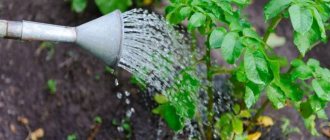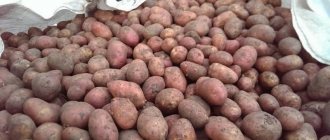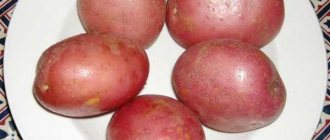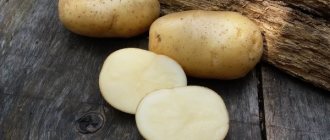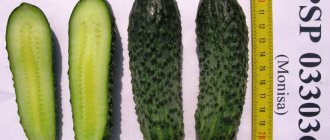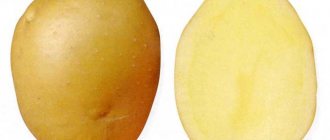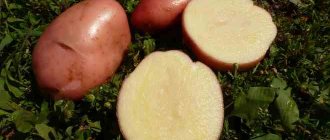The choice of planting material is a responsible process. It is necessary to take into account many nuances: the degree of yield, the taste of the product, soil and climate requirements, as well as ripening time. Professional agronomists monitor the cultivation of potatoes on an industrial scale, and the planting areas occupy tens of hectares. Private farms are much more modest. Therefore, it is very important that the selected variety is affected by diseases as little as possible and produces a high yield even from a small area of land. Today, new potatoes from Holland have become popular among summer residents. Description of the variety, photos and reviews of Sifra potatoes are presented below.
Characteristics of the Sifra potato variety
Sifra potato bushes vary in size. Their height can be medium or high. The tops are not too dense with small leaves of a deep green color. The roots are very well developed. Up to 15 large tubers are formed under one bush. The weight of each is from 100 to 150 g. According to the description, Sifra potatoes have an almost regular oval shape. These are smooth potatoes with smooth yellow skin; eyes are rare.
Sifra potatoes are considered unpretentious. Prefers loose and light soils. Collected tubers are well stored and can be transported even over long distances without compromising their presentation. In general, Sifra is resistant to the most common diseases. According to the ripening period, it belongs to the mid-late varieties.
Attention! There is a risk of Sifra potatoes becoming infected with late blight or fungal infection. But with good care, problems rarely arise.
Correct fit
Agricultural technology for the Sifra variety is standard. Basic landing rules:
- Planting material is planted in late spring, in well-warmed soil;
- To grow the Sifra variety, give preference to light, sandy soil. The soil must be thoroughly loosened, getting rid of plant debris that can become a breeding ground for the development of various bacteria and insect pests;
Before planting, carry out mandatory dressing of root crops.
Further care measures include:
- Glaze. There is no need to water until the potatoes begin to bloom. But during dry summers, watering once a week is still necessary. After the flowering period, monitor the moisture level of the potato bed. Before watering, the soil should dry to the depth of one finger. Water potato bushes in the evening, at the rate of two to three liters of water per bush;
- Hilling. The hilling procedure prevents potato bushes from disintegrating and also stimulates the formation of stolons. Hill up twice a season: the first hilling is carried out when the bushes reach a height of 14-16 cm, and the second before the flowering period begins;
- Fertilizers. As a top dressing, give preference to organic fertilizers based on manure or chicken droppings. If the soil composition is poor, it is allowed to use mineral fertilizers, alternating with organic ones. In total, fertilizers are applied three times during the season: as soon as the shoots appear, before and after flowering.
Read also: Tomato “Pepper Orange” - description, photos of tomatoes, reviews about the variety
Secrets of growing potatoes:
Taste qualities of Sifra potatoes
According to characteristics and reviews, the Sifra potato variety has a richer taste when ripened late. The pulp is white, quite juicy, but not watery. Very tasty potatoes with pleasant sweet notes. Widely used in cooking. It can be prepared in a variety of ways: boiled, fried, baked or stewed. The correct shape of the tubers makes them easy to stuff. The puree comes out very tender and homogeneous.
Attention! These potatoes are not too high in calories and contain a sufficient amount of vitamins. Ideal for children and people on a diet.
Origin
The Sifra potato variety was bred by Dutch breeders. Registered in the State Register of the Russian Federation in 2010. Zoned for the Central, Central Black Earth, North-Western, Volga-Vyatka regions of Russia.
We invite you to familiarize yourself with Potato boats in the oven
Recommended for industrial cultivation, farming or personal plots. Large, smooth tubers are ideal for retail sale. They look attractive on the counter and are stored for a long time without losing their commercial qualities. Transportation over long distances is possible.
Pros and cons of the variety
The obvious benefits of Sifra potatoes include:
- fairly high yields;
- possibility of long-term storage (if the tubers were dug in dry weather);
- absence of signs of degeneration in seed material;
- aesthetic appearance of tubers (even color and almost regular geometric shape);
- potatoes tolerate drought well;
- stable immunity to diseases;
- Widely used in cooking.
Regarding the negative characteristics of Sifra potatoes, they are insignificant. Tubers do not tolerate frost, and they also require nutritious soil.
Advantages and disadvantages
In addition to immunity to a number of diseases, high yield and aesthetic appearance, the Sifra variety has other advantages.
Unlike super-early ones, it is drought-resistant and can be stored for a longer time. Sifra shows no signs of degeneration. Potatoes of this variety are used in cooking for dietary and baby food and have a pleasant taste.
Disadvantages of the variety:
- sensitivity to sudden drops in temperature;
- special need for nutritious soil.
REFERENCE: Minor disadvantages include sensitivity to frost, as well as high demands on soil nutrition.
The main advantages of the Sifra potato variety include:
- excellent taste of root vegetables;
- good yield;
- the versatility of potatoes;
- attractive appearance of tubers;
- the harvest is well stored;
- seed material is not subject to degeneration;
- drought resistance;
- resistance to major diseases.
Planting and caring for Sifra potatoes
The activities associated with growing potatoes are known to every gardener. The Sifra variety is practically no different in this regard.
Selection and preparation of a landing site
The place for Sifra potatoes should be with light soils. An excellent option is sandy and sandy loam. Growing on dry peat soils is also acceptable. Depleted, heavy or swampy soil is absolutely not suitable. There will be no good harvest.
The site for Sifra potatoes begins to be prepared in the fall. It all starts with digging (30 cm). The soil must be turned over during the process. The nutritional value is effectively increased by wood ash or humus. The stems and roots of old plants should not be left. They may be contaminated by bacteria or affected by insects. And all this “inheritance” will be passed on to the potatoes, reducing its yield and the quality of the tubers.
It is best to plant Sifra potatoes in an area where beets, herbs, cucumbers, cabbage and green manure plants grew. Other nightshades are not the best option as predecessors. These plants significantly reduce harvest volumes.
Preparation of planting material
Sifra seed potatoes require germination. Approximately 45-60 days before planting, the tubers are transferred to a bright and warm room (no more than + 15 ° C). This time is enough for young sprouts to appear from the eyes. As soon as they reach a length of 1-1.5 cm, you can begin planting. When sprouts appear earlier, the potatoes are hidden in a dark place until the day of planting. Additionally, the tubers are pickled. It is completely safe for humans. As it grows and with the correct regime of fertilizers and watering, all toxic substances will go away.
The Sifra variety grows best in regions with warm climates. It is necessary to wait for stable heat without the threat of frost. The soil should warm up well. Among the people, the optimal date was determined by birch leaves. When they became the size of a small coin, the sowing season was considered open.
Landing rules
Each owner has his own ways of planting Sifra potatoes. Some people prefer to make trenches, most people dig the usual holes. The lighter and softer the earth, the greater their depth. The maximum is 12 cm, and the minimum is 5 cm. It all depends on the quality of the soil. It is pre-moistened. The method of planting under straw has also become common. The optimal distance between bushes is approximately 30 cm, and between rows - 65 cm. The tubers must be covered with a layer of earth. If you follow all the rules, you will be pleased with the first shoots in two to three weeks.
Attention! The so-called straw planting is used as an experimental method.
To do this, the soil on the site is leveled (it must be warmed up), loosened, and small depressions are made into which potatoes are laid out in a row. It is sprinkled with a little earth and covered with straw on top (the thickness of the cover is from 30 to 50 cm).
Watering and fertilizing
It is not recommended to moisten the soil before flowering. In severe drought, Sifra potato bushes are watered once every 7 days. As soon as the first flowers appear, you need to constantly keep the soil moist. This does not imply daily watering, otherwise everything will end in stagnation of water and rot. You can check the condition of the soil by plunging your finger into it. If it remains dry, moisturizing is necessary. Watering is carried out only after sunset. Each Sifra potato bush requires no more than 2-3 liters of water. In order not to overdo it with moisture, drip irrigation is used.
It is best to use organic matter for fertilizing. This could be manure or diluted chicken droppings. The composition of the soil can be enriched by adding mineral fertilizers. They are added in the spring when plowing the area or into the hole during planting. If for some reason this was not done, Sifra potatoes will need to be fertilized in the summer (by root or foliar method). During the season, the procedure is carried out three times: at the first emergence of seedlings, before flowering and after it.
Attention! If the green mass of the bush grows greatly, you need to reduce the amount of nitrogen-containing fertilizers.
Loosening and weeding
This is necessary to regulate soil moisture, remove weeds and provide air access to the root system of the Sifra potato. The first weeding is done a month after planting. By this time, the sprouts will reach a height of 2 to 4 cm, and the second when they grow to 20-30 cm. You need to loosen the soil very carefully so as not to damage the seedlings. You need to fluff up the soil both near the bushes themselves and between the rows. Hoes and choppers are often used as tools. Walk-behind tractors and cultivators simplify the work. If the ground is mulched with dry grass or straw, then there is no need for frequent weeding. Sawdust, fresh mown grass, peat and others are often used as mulch for Sifra potatoes.
Harrowing is also carried out. Twice before germination and the same amount after. At an early stage, the weeds are still fragile, they look like white threads. If you walk over them with a harrow, they will die completely.
Hilling
The essence of the process is to sprinkle the base of the stems with light and fluffy soil. It also helps control weeds and improve root respiration. Tubers will grow much faster, which will have a beneficial effect on yield. The height of the bush should be at least 15-16 cm. The soil from the rows is carefully raked to the base of each bush. The Sifra potatoes are hilled for the second time when they have gained another 10 cm in height.
If the area is quite large, it is convenient to use a walk-behind tractor; it will help save time and effort. The device is placed between the beds and the lowest speed is selected. Using the technique, hilling Sifra potatoes is carried out one-time. All subsequent attempts will damage the tubers.
A little about the important
We owe the pleasure of eating food to Dutch breeders who worked hard to create the Sifra potato variety. And today it enjoys well-deserved respect and popularity among summer residents, farmers and owners of personal plots. If you want to sell large or small quantities of this product, it will not be difficult. Tubers of the same size look impressive on the counter, and those who have at least once tried dishes made from them will want to feel this taste again and again. Therefore, there will always be people everywhere who want to buy potatoes from you.
We have named many advantages, but do potatoes have any disadvantages? Of course, but there are not many of them. This is soil preference (tubers grow better in light or sandy soils) and increased sensitivity to temperatures below 0C. The unpleasant consequences of this can be avoided if planting material is planted after the threat of frost has passed.
The soil must first be loosened. Another important condition is that there should be no last year’s stems or roots left in the soil; they can be favored by bacteria or insects, which will subsequently harm the crop. Experienced gardeners recommend adding ash or a little humus to the bottom of the hole and pickling the tubers. But when using special medications, you need to read the instructions and strictly follow the recommendations. This method of protection does not pose a health hazard; as long as the potato grows, toxic substances will lose their properties, and it will be a very useful product.
Read also: Black radish juice: preparation, indications for use and contraindications
If it is not possible to carry out frequent weeding, the soil can be mulched with straw or dry grass. After hilling the potatoes, mulch is placed between the rows, the result will be amazing. Fertilizers, both organic and mineral complex preparations, will not be superfluous. If the above-ground part of the bush is growing intensively, it’s worth thinking about - perhaps you are carried away by fertilizers containing nitrates? In this case, you should stop, because there is nothing good for health in this. In mid-July it will be possible to dig up a new crop. Only tubers that are dried away from sunlight and that have no visible damage are placed for storage. The potato storage room should be dry and cool.
Potatoes are immune to pathogens of many diseases that affect other varieties, but preventive treatment cannot be neglected. During planting, pour birch ash into the holes, then you will not have to save the crop from fungus or rot. Insecticides that save against parasites must be used strictly according to the instructions, not forgetting about personal protective equipment. The next year's potato field can be planted with cabbage, radish or other crops; this will protect the tubers from wireworms if you plant potatoes a year later in the same place.
Diseases and pests
Sifra potatoes have stable immunity to the most common diseases. Solanaceae are most often affected by nematodes and potato canker. Late blight is sometimes observed on tubers and tops. Treatment with preparations containing high copper content will help as a preventative measure. If you pour a little birch ash into the holes when planting, this will help protect the plantings from rot and fungal infections.
The juicy stems and leaves of Sifra potatoes become a favorite treat for harmful insects. Along with the Colorado potato beetle, gardeners may also encounter potato moths, mole crickets and wireworms. They can be controlled using modern insecticides. You should also disinfect tubers before planting and follow the rules of crop rotation, giving the soil rest.
Description of the variety
The Sifra potato was bred in Holland and entered Russian markets after the variety was entered into the state register in 2010.
Potato composition:
- water;
- starch;
- sugar;
- cellulose;
- raw protein;
- amino acids;
- organic acids;
- minerals;
- amides;
- pectins.
Potatoes are rich in macronutrients:
It also contains vitamins C, A, H, E, group B (thiamine, riboflavin, pyridoxine, pantothenic and folic acids).
Potatoes of the Sifra variety ripen from 95 to 110 days and have high yields, maximum indicators are 500 c/ha.
The variety is resistant to various diseases and pests - scab, potato canker, golden nematode, but is weak against fungal diseases, and is moderately resistant to late blight.
Characteristics of Sifra potatoes
Sifra bushes are medium in size. The leaves are small, dark green, and can spread out or stand upright. During the flowering period, the bushes are covered with white flowers collected in corollas. The potatoes are large, smooth and even, oval in shape with a few eyes. The color of the peel is light yellow, the flesh is white or light cream.
The Sifra potato has earned the trust of gardeners for its resistance to the climatic conditions of a number of regions - Central, Northwestern, Central Black Earth, Volga-Vyatka. This variety is actively grown in Moldova and Ukraine.
Important! The Sifra variety is sensitive to frost, so it is better to start planting during a period of stable heat, when the soil has time to warm up sufficiently.
Storage
Sifra potatoes have excellent keeping quality. Even after long-term storage, it retains its aesthetic appearance and all its taste. It is best to store tubers in a prepared cellar using wooden containers or plastic boxes. Before planting, all tubers must be picked from the ground and dried. Then everything is carefully sorted out. The ideal temperature for storage is 4-7 °C with air humidity within 60-65%. If all standards are followed, Sifra potatoes will last until spring without loss.
Reviews of Sifra potato varieties
Varvara Evgenievna Kozentsova, 50 years old, Nikopol
This year marks 20 years since my husband and I have had a dacha. The climate in our area is mild, so there are no problems with crops. A neighbor advised us to try a new potato variety - Sifra. We decided why not. We looked after the plantings as usual. They dug up a very decent harvest, and there was practically no spoilage. The potatoes are tasty and boiled. Thanks neighbor for the good advice!
Dmitry Ivanovich Kozhedub, 40 years old, Borzna
I've been working on potatoes for a long time. I recently discovered the Sifra variety. Gives an excellent harvest. The tubers are healthy and beautiful. I took vegetables to sell in the city, people bought them quickly and ordered more.
Irina Semyonovna Netrebnaya, 37 years old, Bakhmut
Sifra potatoes attracted my attention with their beautiful tubers, and I was pleased that there were almost no eyes. There were no particular difficulties with cultivation. We collected more than 300 kg. They immediately sent everything to the basement, almost nothing was missing. I recommend to everyone!
Features of cultivation
Agricultural technology for this potato is standard. Like other mid-late varieties, “Sifra” is planted in late spring, when the soil is well warmed up. The soil should be light, preferably sandy . The soil is carefully loosened, selecting plant remains that can become a breeding ground for bacteria and insect pests. Humus or wood ash is laid out in the holes.
Pre-planting treatment of tubers is required . During growth, toxic components will be completely released; with proper watering and feeding, young potatoes will become absolutely safe.
Read more about how to feed potatoes, when and how to apply fertilizers, how to do this at the time of planting and what are the best fertilizers.
The variety is sensitive to soil moisture. To make the root crops large and beautiful, it is advisable to organize a drip irrigation system . Mulching the soil with straw or mowed grass will help maintain a normal level of humidity and eliminate frequent weeding. It is laid out between the rows after hilling. Hilling up plantings can be done either manually or using machinery.
The plantings are watered 2-3 times per planting season with liquid complex fertilizer with a predominance of potassium and magnesium. Mineral complexes should be alternated with organic matter: diluted bird droppings or mullein .
You can dig up the first tubers in mid-summer . However, the variety demonstrates maximum productivity at the end of the growing season, in the second half of September. Before digging, it is recommended to cut off all the tops from the bushes. After harvesting, the harvested potatoes are sorted and thoroughly dried at the edge or under a canopy.


